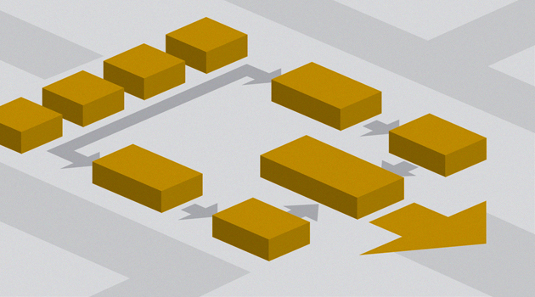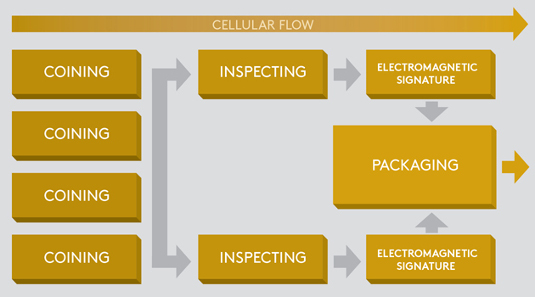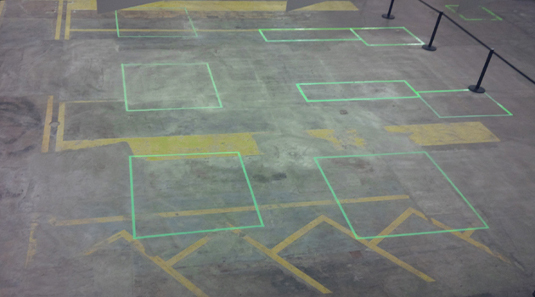September 11, 2014 – The Royal Canadian Mint is embarking on a very ambitious project: cellular manufacturing. By reconfiguring equipment and processes in its Winnipeg facility to use resources more efficiently, the time it takes to go from coining to final packaging will be cut from days to hours.
In traditional manufacturing, production equipment is grouped so that specific areas of a plant are dedicated to individual stages of the larger process. In the minting context, this might mean all the coining presses are located in one area and all the packaging equipment another. This causes bottlenecks: masses of coins are held at each location, waiting for a large enough quantity to be processed before moving to the next stage.
The principle of cellular manufacturing: small clusters (cells) of workstations and equipment arranged in a sequence.
Cellular manufacturing stems from the world-recognized lean enterprise approach adopted more than 10 years ago by the Mint. In cellular manufacturing, small clusters (or cells) of workstations and equipment are arranged in a sequence that supports the continuous flow of materials through the entire production process with minimal transport or delay. In doing so, capital spending and labor hours can both be maximized, resulting in a product that is not only high quality but also more cost effective. The Mint has extensively researched how to introduce cellular manufacturing into its production environment. After several months of preparation, an initial pilot cell will be up and running later this summer.
Cellular manufacturing of coins.
It will include four coining presses and eight blank hoppers, while a unique ‘spring-pin’ design will allow various technology stations—such as vision inspection, EMS testing and packaging equipment—to be moved in and out on an as-needed basis. A series of modular conveyors will seamlessly transport product between machines.
“The beauty of cellular manufacturing is that it gives you so much flexibility,” says Tom Roche, Senior Director of Manufacturing at the Mint’s Winnipeg facility. “This design will make it easy to incorporate a huge variety of equipment to meet the different demands of customers around the world.”
Roche notes that the Mint’s pilot cell will be tested in isolation from primary production areas to ensure the Mint’s current delivery schedule and level of customer service are unaffected.
The factory floor at the Winnipeg facility.
Once enough data has been gathered and the process tweaked accordingly, the first full production cell will be installed on the coining floor—possibly by the end of this year.
“This will be the template for going forward,” he explains. “It’s a major change—but it will put us in a better position to win more work and provides the stability to build a more engaged, satisfied workforce.”
This article appeared originally on the Inside Minting blog of the Royal Canadian Mint.
More information about the Royal Canadian Mint you find on the website of the Mint.
We republish it courtesy of The Royal Canadian Mint. ©2014 Royal Canadian Mint. All rights reserved.







